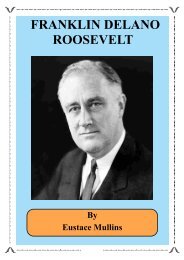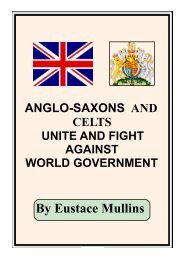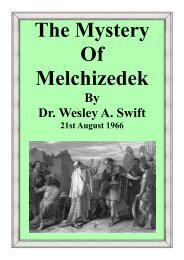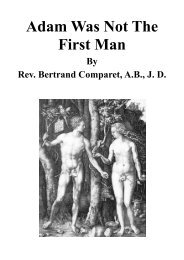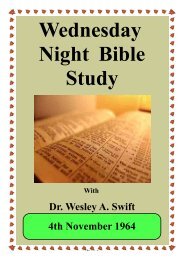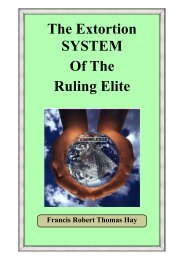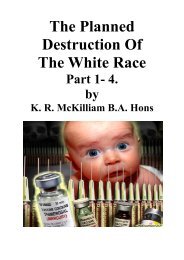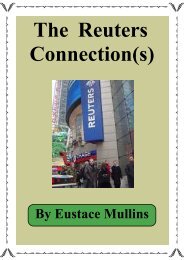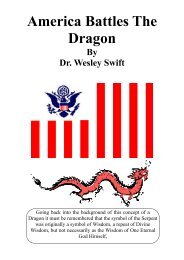Curse of Cannan - The New Ensign
Curse of Cannan - The New Ensign
Curse of Cannan - The New Ensign
You also want an ePaper? Increase the reach of your titles
YUMPU automatically turns print PDFs into web optimized ePapers that Google loves.
Between 1827 and 1843, the plans <strong>of</strong> the conspirators received a temporary setback with the<br />
emergence <strong>of</strong> the AntiMasonic Party as a national force. This political movement threatened to<br />
expose the entire conspiracy as a Masonic operation. From its outset, the Anti-Masonic Party<br />
was handicapped by its inability to penetrate the shroud <strong>of</strong> secrecy which veiled every act <strong>of</strong> the<br />
conspirators. Without direct evidence <strong>of</strong> this conspiracy which could be presented in court or<br />
laid before the people, they soon lost their popular support. In fact, they were soon infiltrated by<br />
the very conspirators whom they sought to expose, and they were rendered impotent! Albert<br />
Pike later boasted that "<strong>The</strong> Anti-Masonic Party actually was <strong>of</strong> great assistance to us." After its<br />
dissolution, Freemasonry never again faced any organized opposition in the entire United States.<br />
Those who mention this subject are quickly discredited as "poor overwrought fools" and paranoid<br />
"Know-Nothings" who see Masons behind every tree. In most cases, they are quickly consigned<br />
to the nearest lunatic asylum, a la Soviet Communism's handling <strong>of</strong> its "dissidents. "<br />
For some years prior to the outbreak <strong>of</strong> the Civil War, the Young American Masonic conspiracy<br />
had been active in the Southern states, laying the groundwork for the approaching Civil War. A<br />
native <strong>New</strong> Yorker, John A. Quitman, moved to Mississippi and married into a wealthy Southern<br />
family. He was given the warrant to form a Scottish Rite organization in Mississippi. On February<br />
1, 1848, the Freemason magazine <strong>of</strong> Boston carried the notice that Brother John Quitman, who<br />
was now a Major General in the United States Army, had been inaugurated as Sovereign Grand<br />
Inspector General <strong>of</strong> the 33rd degree. All Southern Lodges were now ordered to obey him.<br />
Quitman had also become one <strong>of</strong> the most outspoken leaders <strong>of</strong> the secessionist movement in<br />
the South; this movement was now firmly controlled by the Masonic Canaanite conspirators.<br />
Quitman also sponsored a plan to annex Mexico, and financed an invasion <strong>of</strong> Cuba by<br />
mercenaries. He had been elected Governor <strong>of</strong> Mississippi, when he was indicted in <strong>New</strong> Orleans<br />
for his part in the planned Cuban invasion, and he was forced to resign from that <strong>of</strong>fice. Here<br />
again was the deep involvement <strong>of</strong> a leader <strong>of</strong> the Scottish Rite, the revolutionary arm <strong>of</strong><br />
Freemasonry, in planning wars and revolutions throughout the world. <strong>The</strong> ideological leader <strong>of</strong><br />
the Cuban invasion was one Jane McManus, who had last been heard from as the girl friend <strong>of</strong><br />
the revolutionist, Aaron Burr.<br />
In order to build popular support for his Presidential campaign, Senator Stephen Douglas,<br />
Lincoln's opponent, hired one George Sanders, 'a Young America agent, to edit the Democratic<br />
Party Review. Sanders is identified in Who's Who by pr<strong>of</strong>ession as a "revolutionist." <strong>The</strong><br />
American political agent <strong>of</strong> the Hudson Bay Company, he had worked for the Bank <strong>of</strong> England,<br />
and as United States Consul in London, he had worked closely with Mazzini. London was at<br />
that time the world headquarters <strong>of</strong> Masonic revolutionary movements. Sanders soon devoted<br />
the pages <strong>of</strong> <strong>The</strong> Democratic Party Review to lauding the efforts <strong>of</strong> Mazzini and other Masonic<br />
agitators.<br />
In 1853, Killian H. van Rensselaer, one <strong>of</strong> the <strong>New</strong> York "patroons," or hereditary landlords,<br />
opened the Western Headquarters <strong>of</strong> the Scottish Rite in Cincinnati, Ohio. At the same time,<br />
another secret organization, the Knights <strong>of</strong> the Golden Circle, began its operations in Cincinnati.<br />
<strong>The</strong> organization, which, as usual, was well-financed, soon enlisted and trained some 100,000<br />
members in paramilitary tactics. <strong>The</strong>se members spread throughout the Southern States; they<br />
formed the nucleus <strong>of</strong> what would become the Confederate Army during the Civil War. Most<br />
Southerners neither envisioned nor prepared for an armed struggle with the North. <strong>The</strong> "Southern"<br />
cause was always directed and promoted by "Northern" infiltrators. <strong>The</strong> stage was now set for<br />
the Civil War.<br />
<strong>The</strong> nation was further polarized by the Dred Scott case. Scott, an elderly and infirm Negro who<br />
was financially supported by his owners, was pushed into a direct legal confrontation, amply<br />
financed from <strong>New</strong> England merchant bankers funds. <strong>The</strong> case went to the Supreme Court. Listed<br />
in the court records as "Dred Scott v. Sanford, 19 Howard 393," the matter was decided in an<br />
opinion by Chief Justice Taney dated March 6, 1857. "<strong>The</strong> question is simply this; can a negro,<br />
whose ancestors were imported into this country, and sold as slaves, become a member <strong>of</strong> the<br />
( Page 77)



